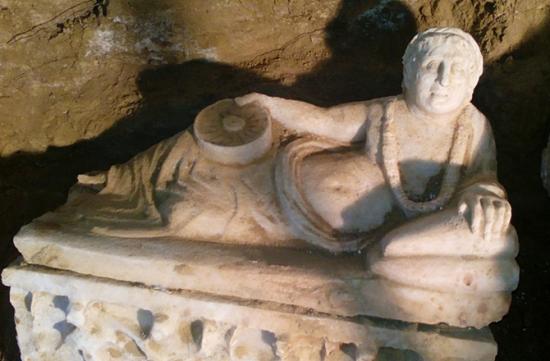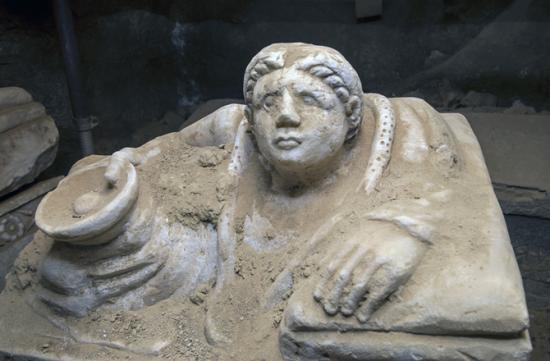Rossella Lorenzi
Source - http://news.discovery.com/history/archaeology/intact-packed-etruscan-tomb-found-151204.htm
 One of the reclining figures on the lid of the urn - SOPRINTENDENZA ARCHEOLOGIA DELL'UMBRIA
One of the reclining figures on the lid of the urn - SOPRINTENDENZA ARCHEOLOGIA DELL'UMBRIA
An intact Etruscan tomb, complete with sarcophagi, a full array of grave goods and a mysterious marble head, has has been brought to light in the Umbria region of Italy, in what promises to be one of the most important archaeological findings in recent history.
Dated to the end of the 4th century B.C., the burial site was found by a farmer who opened a void in the earth while working with his plow in a field near Città della Pieve, a small town some 30 miles southwest of Perugia.
“It was a totally unexpected discovery. The area is away from the sites visited by tomb robbers and indeed the burial is undisturbed,” Clarita Natalini of the archaeological superintendency of Umbria, told Discovery News.
Finding an undisturbed Etruscan tomb is an extremely rare event that has the potential to reveal more about one of the ancient world’s most fascinating and mysterious cultures.
The Etruscans were a fun- loving and eclectic people who among other things taught the French how to make wine, the Romans how to build roads, and introduced the art of writing into Europe. They began to flourish around 900 B.C., and dominated much of Italy for five centuries.
Known for their art, agriculture, fine metalworking and commerce, they began to decline during the fifth century B.C., as the Romans grew in power. By 300-100 B.C., they eventually became absorbed into the Roman empire.
Since their puzzling, non-Indo-European language was virtually extinguished (they left no literature to document their society), the Etruscans have long been considered one of antiquity’s great enigmas.
Much of what we know about them comes from their cemeteries. Only the richly decorated tombs they left behind have provided clues to fully reconstruct their history.
In this way, the burial in Città della Pieve looks more than promising. As Natalini and her team reached the dromos (the corridor leading to the tomb’s entrance) they found themselves in front of a perfectly sealed double door made from heavy stone.
Once opened, the tomb revealed a 16 square-foot rectangular chamber with two sarcophagi, four marble urns and various grave goods. One of the sarcophagi, made from stone, bears a long inscription.
So far Natalini and colleagues have been able to read the word “Laris.” Lars is a common Etruscan male first name. The stone coffin contains the skeleton of a male individual.
Natalini and her team expect to find more information in the inscription, such as the deceased’s family name, the name of his parents, and possibly his age at death.
The other sarcophagus, covered with painted plaster, also shows an inscription.
 Another figure on the lid of one of the urns containing the ashes of the deceased. SOPRINTENDENZA ARCHEOLOGIA DELL'UMBRIA
Another figure on the lid of one of the urns containing the ashes of the deceased. SOPRINTENDENZA ARCHEOLOGIA DELL'UMBRIA
“Unfortunately a collapse which occurred in antiquity damaged the plaster. The inscription is now lost in thousand of fragments. Piecing them together won’t be an easy task,” Natalini said.
Despite the damage, the 2,300-year-old painted coffin, which weights 3 tons and is more than 8 foot long, is still sealed.
“We expect to find another skeleton inside,” Natalini said.
A mysterious marble head, clearly broken at the neck level, has been also found.
“It portrays the beautiful face of a young man. We do not know yet its meaning. Perhaps it was part of a statue that honored one of the deceased,” Natalini said.
Apart from grave goods, which include pottery, miniature votive vases and two intact ceramic jars, likely used to store food for the afterlife, the archaeologists found four urns with cremains.
Made from fine grained alabaster marble, three of them are finely sculpted. The lid portrays the half naked deceased with a flower necklace reclining on two cushions as if at a banquet. He bears a patera, a shallow ritual offering dish, in the right hand.
The use of alabaster marble, the style of the burial and clues from the inscriptions suggest the burial belongs to an aristocratic family from the nearby Etruscan stronghold of Chiusi, Natalini said.
“We will do our best to display the tomb’s content to the public in a close future,” culture council Carmine Pugliese told reporters.
The sarcophagi and the other grave goods have now been moved to a museum in Città della Pieve in order to conduct restoration and further study.